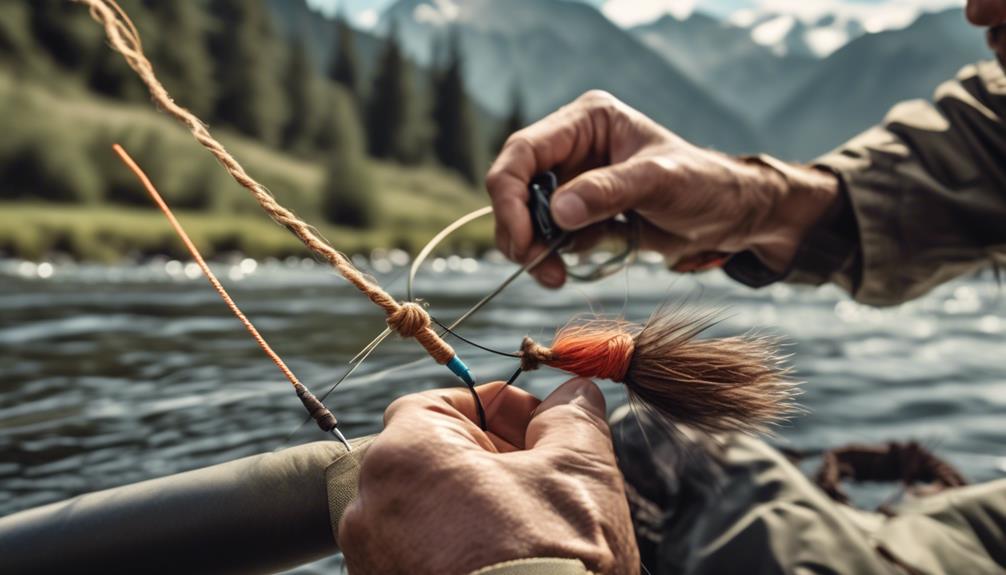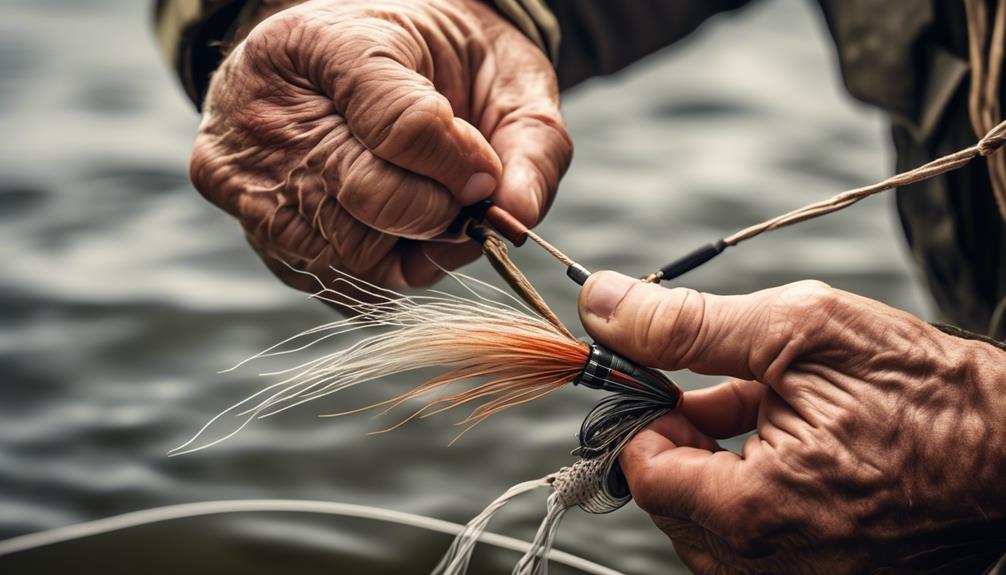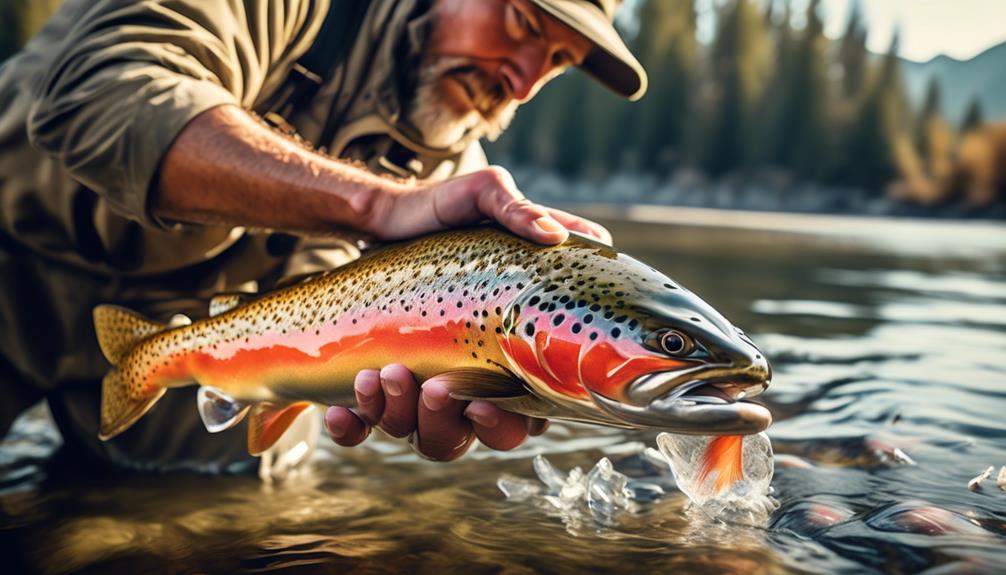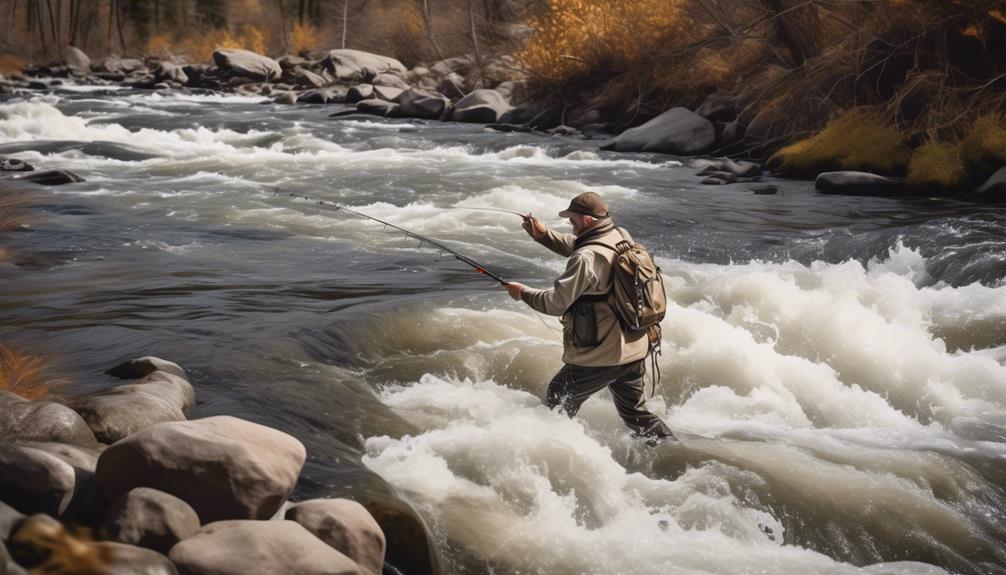So, you've finally made it to the serene riverbank, the sun glinting off the water, and you're ready to cast your line.
But before you do, have you ever stopped to consider the crucial role that tying a fly fishing leader plays in your success on the water? It may seem like a small detail, but the leader is the vital connection between your fly line and the fly itself, and getting it right can make all the difference in your ability to entice those elusive trout.
But why exactly is tying a fly fishing leader important? Well, let's just say it's not a topic to be taken lightly.
Understanding the Purpose of a Fly Fishing Leader
Understanding the purpose of a fly fishing leader is crucial for effectively presenting your fly to the fish. The leader serves as the crucial connection between the fly line and the fly, and its design significantly impacts your fishing success. Leader visibility and casting accuracy are essential factors for a successful fishing experience. A well-constructed leader can greatly enhance your ability to present the fly accurately and delicately to the fish.
Leader visibility is a key consideration when selecting the appropriate leader for your fishing conditions. A leader that's too visible may alert the fish to the presence of the line, causing them to become wary and reluctant to strike. On the other hand, a leader that's too subtle may result in lost flies due to break-offs. Finding the right balance in leader visibility is crucial for maximizing your chances of enticing the fish to take the fly.
Furthermore, leader taper plays a vital role in fly presentation. The taper determines how energy is transferred from the fly line to the leader and, ultimately, to the fly. A well-designed taper allows for smooth turnover and precise fly placement, contributing to improved casting accuracy and delicate fly presentation. By understanding the impact of leader taper on fly presentation, you can select leaders that best suit the specific fishing conditions you encounter, ultimately increasing your chances of a successful fishing trip.
Choosing the Right Leader Material
To ensure optimal fly presentation and maximize your chances of enticing the fish to take the fly, the choice of leader material becomes crucial in achieving the right balance of visibility and strength. When selecting leader material, it's essential to consider its strength and durability. Here are some key points to consider when choosing the right leader material:
- Leader Material Strength and Durability
- Look for materials that offer high tensile strength to withstand the force of a hooked fish, especially when targeting larger species.
- Consider the durability of the material, as it should resist abrasion from rocks, debris, and the fish's teeth, ensuring it remains intact throughout your fishing trips.
- Choosing Leader Material Diameter and Visibility
- Opt for a leader material diameter that's appropriate for the type of flies and fishing conditions you'll be encountering.
- Thicker diameters provide more strength, whereas thinner diameters offer better presentation and are less visible to fish.
- Consider the visibility of the leader material in different water conditions.
- In clear water, a thinner, less visible leader may be necessary to prevent spooking fish, while in murky water, visibility may be less of a concern.
Selecting the Appropriate Leader Length
When selecting the appropriate leader length for fly fishing, consider the specific fishing conditions and the behavior of the targeted fish species. The leader taper, which is the gradual decrease in diameter from the fly line to the tippet, plays a crucial role in presenting the fly naturally to the fish. In general, longer leaders are suitable for calm, clear water conditions and wary fish, as they provide better leader visibility and help in achieving delicate presentations.
On the other hand, shorter leaders are more suitable for windy conditions or when casting larger flies, as they offer better casting accuracy and control.
For fishing in small streams or when targeting spookier fish, a longer leader of 9-12 feet may be necessary to ensure a more delicate presentation. In contrast, when fishing in larger rivers or lakes with windy conditions, a leader length of 7-9 feet might be more appropriate to maintain casting accuracy and control. Additionally, if you're using heavy or large flies, a shorter leader of around 7-9 feet can help in casting these flies with precision and control.
In essence, understanding the relationship between leader length and fishing conditions is essential for successful fly fishing. By selecting the appropriate leader length based on the specific fishing conditions and the behavior of the targeted fish species, you can enhance your chances of presenting the fly naturally and effectively, ultimately leading to more successful fishing experiences.
Tying the Nail Knot for Leader Attachment
For secure and reliable attachment of the leader to the fly line, the nail knot is an essential technique in fly fishing. This knot, often tied using a nail or a specialized tool, provides several advantages:
- Strength and Durability: The nail knot is known for its strength, ensuring that the leader remains securely attached to the fly line even when reeling in large fish or navigating through rough waters.
- *Comparison*: In comparison to other leader attachment methods such as loop-to-loop connections or snap swivels, the nail knot offers superior strength and durability, making it a preferred choice for many fly anglers.
- Smooth Casting: The streamlined profile of the nail knot facilitates smoother casting by reducing any bulky or uneven connections between the leader and the fly line.
- *Comparison*: Unlike bulky knots or clips which may cause air resistance during casting, the nail knot minimizes any interference, allowing for more precise and effortless casting.
While the nail knot technique may require practice to perfect, its advantages make it a popular choice for fly anglers seeking a reliable and low-profile leader attachment.
Despite its effectiveness, it's essential to be familiar with alternative leader attachments to make an informed decision based on fishing conditions and personal preferences.
Attaching Tippet to the Leader
You can attach the tippet to the leader using a simple and effective knot known as the double surgeon's knot. This knot is reliable and easy to tie, making it a popular choice among fly fishers.
When attaching the tippet to the leader, it's essential to consider the strength of the tippet and the flexibility and durability of the leader. The tippet strength should complement the leader's strength to ensure a smooth transfer of energy when casting and to withstand the pressure of potential catches.
The double surgeon's knot is ideal for connecting the tippet to the leader as it maintains a high percentage of the line's original strength. This is crucial because it ensures that the tippet-to-leader connection can withstand the force of a strong fish without breaking. Additionally, the knot's design allows for easy and smooth movement through the rod guides, contributing to the overall flexibility of the leader.
Choosing the right knot for attaching the tippet to the leader is paramount. The double surgeon's knot provides a strong and reliable connection, ensuring that the tippet and leader work together seamlessly. With this setup, you can cast accurately and present your fly effectively, increasing your chances of a successful catch.
Furthermore, it promotes a balanced system where the leader's durability is complemented by the appropriate tippet strength, creating an efficient and effective fly fishing setup.
Securing the Leader to the Fly Line
To secure the leader to the fly line, use a nail knot for a strong and streamlined connection that minimizes drag during casting. The leader's strength and durability are crucial for withstanding the tension and pressure that comes with fly fishing. When tying the leader to the fly line, it's important to use the right knot tying techniques and tools to ensure a secure connection that won't fail during a big catch.
- Knot Tying Techniques
- When tying a nail knot, use a nail knot tool or a small-diameter tube to make the process easier and more precise. This will help you create a tight and secure connection between the leader and the fly line.
- Practice tying nail knots before heading out to fish. Familiarizing yourself with the technique will make it easier to tie a strong and reliable knot when you're out on the water.
- Tools for Securing the Connection
- Invest in a good quality nail knot tool to make the process of tying the leader to the fly line more efficient. This tool can help you create a tight knot without struggling with slippery lines and small spaces.
- Consider using a pair of hemostats to hold the tag end of the leader and the fly line together, making it easier to tie a secure nail knot.
Adding a Dropper to the Leader

After securing the leader to the fly line, consider adding a dropper to the leader for the versatility of fishing multiple flies at different depths. The dropper can be added by tying a short section of tippet material to the leader using a clinch knot.
The dropper placement is crucial for effectively presenting multiple flies and employing various fishing techniques. By customizing the leader with a dropper, you can enhance your fly presentation and increase your chances of enticing fish to bite.
When adding a dropper to the leader, it's important to determine where it will be most effective. If you're fishing a nymph pattern, placing the dropper closer to the end of the leader can help in presenting the fly at the desired depth. This can be especially useful when targeting fish in deeper water or during times when they're feeding near the bottom.
On the other hand, if you're using a dry fly as the main pattern and want to add a smaller emerger pattern as the dropper, positioning the dropper further up the leader can be advantageous.
Tips for Maintaining a Strong Leader Knot
For maintaining a strong leader knot, consider using a double preposition to ensure a secure connection between the leader and the fly line. This technique involves passing the leader through the fly line's loop twice before tying the knot, which significantly enhances its strength and prevents slippage.
In addition to this method, there are several other tips for maintaining a strong leader knot:
- Choose the Right Knot: Opt for a knot that's specifically designed to maintain strength and prevent slippage. For instance, the double surgeon's knot or the triple surgeon's knot are excellent choices for securing the leader to the fly line.
- *Maintaining Strength:* When tying the leader to the fly line, ensure that the knot maintains the strength of both the leader and the fly line. A weak knot can result in breakage, leading to lost fish and frustration.
- *Preventing Slippage:* The knot should be tied in a manner that prevents slippage, especially when casting or reeling in a catch. This is crucial for maintaining the connection between the leader and the fly line, ensuring that the two don't separate during a critical moment.
Frequently Asked Questions
Can a Regular Fishing Line Be Used as a Leader in Fly Fishing?
Yes, a regular fishing line can be used as a leader in fly fishing, but it's not ideal. It's important to learn leader knot techniques and use versatile leaders to avoid consequences of improper knots.
Are There Any Special Techniques for Tying a Leader Knot in Windy Conditions?
In windy conditions, tying techniques for a leader knot are crucial. Focus on using a secure knot like the improved clinch knot. Keep the line taut and maintain control to ensure a strong connection.
How Often Should a Fly Fishing Leader Be Replaced?
For leader maintenance, it's important to consider lifespan and best practices. Depending on usage, replace your fly fishing leader every few outings to ensure optimal performance and avoid breakage during crucial moments on the water.
Can a Leader Be Used for Different Types of Fly Fishing, or Is It Specific to Certain Types of Flies?
When fly fishing, a leader can be used for different types of flies. It's versatile and has various applications in fly fishing. The leader knot is specific to the type of fishing and the flies being used.
What Are the Potential Consequences of Using an Improperly Tied Leader Knot While Fly Fishing?
Using an improperly tied leader knot while fly fishing can lead to potential consequences such as lost fish, broken lines, and missed opportunities. It's crucial to master proper technique to avoid these issues.
Conclusion
So, now you know why tying a fly fishing leader is important.
By understanding the purpose of the leader, choosing the right materials, and properly attaching it to your fly line, you can ensure a strong and effective connection between your line and your fly.
With the right leader knot, you can have more control over your cast and improve your chances of catching that big one.
Happy fishing!



